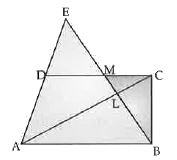A hemispherical depression is cut out from one face of a cubical wooden block such that the diameter l of the hemisphere is equal to the edge of the cube. Determine the surface area of the remaining solid. Solution in Kannada
The correct Answer is:l24(24+π) sq. unit.
Step by step video, text & image solution for A hemispherical depression is cut out from one face of a cubical wooden block such that the diameter l of the hemisphere is equal to the edge of the cube. Determine the surface area of the remaining solid. by Maths experts to help you in doubts & scoring excellent marks in Class 10 exams.
Updated on:21/07/2023Topper's Solved these Questions
- SURFACE AREAS AND VOLUMESBOOK - ZEN PUBLICATIONCHAPTER - SURFACE AREAS AND VOLUMESEXERCISE - TEXTUAL EXERCISES (EXERCISE 15.2)
8 Videos
- SURFACE AREAS AND VOLUMESBOOK - ZEN PUBLICATIONCHAPTER - SURFACE AREAS AND VOLUMESEXERCISE - TEXTUAL EXERCISES (EXERCISE 15.3)
9 Videos
- SURFACE AREAS AND VOLUMESBOOK - ZEN PUBLICATIONCHAPTER - SURFACE AREAS AND VOLUMESEXERCISE - ZEE ADDITIONAL QUESTIONS -HOTS [HIGHER ORDER THINKING SKILLS]-QUESTIONS
11 Videos
- STATISTICS BOOK - ZEN PUBLICATIONCHAPTER - STATISTICS EXERCISE - ZEN ADDITIONAL QUESTIONS IIT FOUNDATION
5 Videos
- TRIANGLESBOOK - ZEN PUBLICATIONCHAPTER - TRIANGLESEXERCISE - ZEE ADDITIONAL QUESTIONS - LONG ANSWER TYPE QUESTIONS
10 Videos
Similar Questions
A solid in the shape of a cone standing on a hemisphere with both their radii being equal to 1 cm and the height of the cone is equal to its radius. Find the volume of the solid in terms of π.
View SolutionA metallic sphere of radius 4.2cm is melted and recast into the shape of a cylinder of radius 6cm. Find the height of the cylinder.
View SolutionA sector of a circular is of radius 12 cm and angle 120∘. It is rolled up so that two bounding radii are joined together to form a cone. Find the volume of the cone.
View SolutionThe mean of five numbers is 18. If one number is excluded then their mean is 16. Find excluded number.
View SolutionThrought the mid-point M of the sides of a parallelogram ABCD, the line BM is drawn intersecting AC at L, and AD produced to E. Prove that EL=2BL.

View SolutionA hemispherical depression is cut out from one face of a cubical wooden block such that the diameter lof the hemisphere is equal to the edge of the cube. Determine the surface area of the remaining solid.
View SolutionA hemispherical depression is cut out from one face of a cubical wooden plank such that the diameter 4 of the hemisphere is equal to the edge of the cube.Determine the surface area of remaining solid.
View SolutionA hemispherical depression is cut out from one face of a cubical wooden block such that the diameter ‘l’ of the hemisphere is equal to the edge of the cube. Determine the surface area of the remaining solid.
View SolutionA hemispherical depression is cut out from one face of a cubical block of side 7cm, such that the diameter of the hemisphere is equal to the edge of the cube.Find the surface area of the remaining solid.
View SolutionA hemispherical depression is cut-out from one face of the cubical wooden block such that the diameter l of the hemisphere is equal to the edge of the cube. Determine the surface area of the remaining solid.
View SolutionA hemispherical depression is cut out from one face of a cubical wooden block of edge 21 cm, such that the diameter of the hemisphere is equal to the edge of the cube. Determine the volume and total surface area of the remaining block.
View SolutionA hemisphere is cut out from one face of a cubical wooden block such that the diameter of the hemisphere is equal to the edge of the cube. Determine the surface area of the remaining solid.
View SolutionA hemispherical depression is cut out from one face of a cubical wooden block such that the diameter l of the hemisphere is equal to the edge of the cube. Determine the surface area of the remaining solid.
View SolutionA hemisphere is cut from one face of a cubical wooden block such that the diameter of the hemisphere is equal to the side of the cube. Determine the total surface area of the remaining solid.
View SolutionA hemisphere is cut from one face of a cubical wooden block such that the diameter of the hemisphere is equal to the side of the cube. Determine the total surface area of the remaining solid.
View SolutionA hemisphere is cut from one face of a cubical wooden block such that the diameter of the hemisphere is equal to the side of the cube. Determine the total surface area of the remaining solid.
View Solution
